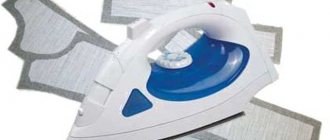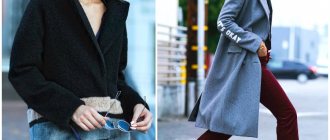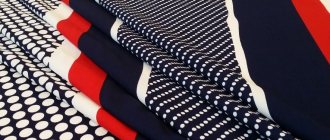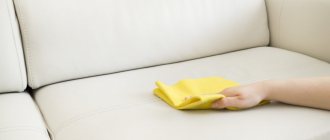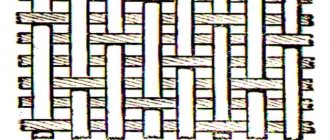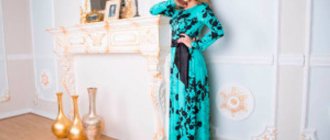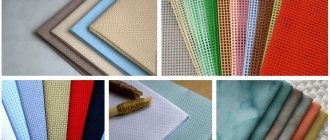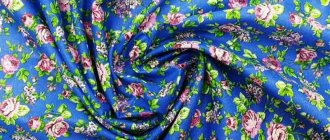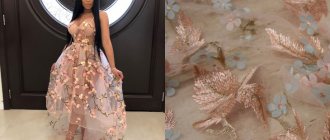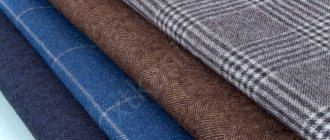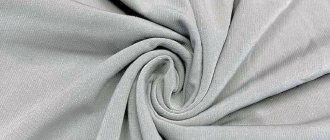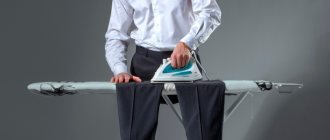Among modern types of textiles, non-woven materials occupy a significant place. A very common one is non-woven fabric, which allows you to securely fix the surface of the fabric and create clear design lines without weighing down the clothing. For ease of use, it is often produced in the form of tapes with glue applied to one surface. This material is called formband (“tape for creating a shape”), it is widely used in individual and industrial tailoring, as well as for decorative purposes, and has several varieties that expand the scope of its application.
Production
Interlining is not a fabric, it is a paper-like fiber. Made from viscose, sometimes with the addition of polyester, it has a fibrous composition. Based on modified cellulose fibers, a liquid carrier and additives, paper pulp is prepared, which is converted into the form of a long strip, pressed, glued (if necessary), and then dried. The finished canvas is rolled into rolls with a width of 30 to 150 cm. It can be painted or unpainted.
To make a formband, the resulting fabric is cut into oblique strips 12 mm wide, which are stitched with a chain stitch for greater strength, and wound onto a reel. Comes in white and black.
Origin story
Answering the question of what non-woven fabric is, you can understand the history of its origin. This is not fabric at all, but a paper-like interlining fabric. But it so happened that water-soluble non-woven formband is usually called fabric due to its widespread use in sewing clothes, for beading and cross stitching.
The fibers that make up the non-woven formband appeared in the last century. For the first time they began to be manufactured at German enterprises. In the domestic industry, non-woven formband appeared at the end of the 20th century, and became widespread in the last decade.
Kinds
Non-woven fabric can be non-removable (water-insoluble) or removable (water-soluble).
- The first serves to give the product strength and wear resistance during operation, and also helps to better keep its shape.
- The removable one is used only during the work process (sewing or embroidery); after all work is completed, the item is washed and the interlining simply dissolves.
It comes with or without adhesive.
- The glue layer can be continuous or dotted. This type of cushioning material is connected to the main one using a heated iron.
- Non-adhesive is applied to the part and pinned with needles so that it does not move during work.
For patchwork, quilts and other types of needlework, soft lambrequins and curtain grips, voluminous non-woven fabric is used. And what it is is very easy to determine by the name itself: it is a lightweight, bulky adhesive-based gasket.
Current styles of chiffon evening dresses for celebrations
Chiffon is an ideal fabric for evening wear. It combines the royal nobility of satin and the flowing lightness of silk. The most popular models of the season are loose sundresses, dresses with high waists and open shoulders. When it comes to length, there is a wide choice:
- Women who want to hide their full legs are recommended to wear long dresses with a fitted bodice.
- For ladies with slender legs, shortened models decorated with folds in the neckline are suitable.
If we talk about shades, then for evening dresses they traditionally choose monochromatic options with jewelry or accessories in contrasting colors.
Functions and scope of application
The main task of this material is to give the part or the entire product strength and wear resistance, as well as shape.
Formband is used for:
- strengthening of some parts of clothing: neckline, bottom of knitwear, shoulder seams, shelves, and other elements that are most subject to stress during operation. With it, the fabric will not stretch and sag. Easily fits along semicircular cuts (45 degree angle);
- easier sewing of very thin fabrics;
- embroidery with thread or beads. With its help, the fabric will not wrinkle, and the threads will be laid more tightly.
The stitched formband does not stretch, but retains its plasticity.
Read about: textiles for creating Korovlevsky design: Arben fabrics
Outfit models size +
In order not to make a mistake in choosing a model, you should familiarize yourself with the patterns that exist between the style of the dress and its “hidden” function in visually improving the figure:
- Babydoll and empire style outfits will help hide extra centimeters at the waist. They distract attention from the stomach, focusing on the bust.
- Trapezoidal options will perfectly hide the volume in the hips.
- Massive shoulders will become visually smaller if you wear a model with ¾ sleeves. Long flared sleeves will make your arms look slimmer and slimmer.
- The drapery on the bodice of the dress will cover your tummy.
- Long chiffon dresses will look impressive on a plump woman at a special event. Floor-length dresses will hide thick calves from others.
- A chiffon dress can be given a highlight by lace inserts, satin ribbons at the waist or collars made of beads and beads.
Summer look
Choose an ultra-fashionable vest dress.
Where can I buy
Formband is sold in any sewing store; you can buy the length you need (usually in meters) or a whole spool.
If you don’t have it in the store, you can take a regular non-woven fabric of the required density, cut it on the bias into 1.2 cm strips. At a distance of 4 mm from the edge of the strip, draw a thin line (along the entire length) and stitch it on a machine. Then work in the same way as with the finished tape.
Useful
The seam should be a chain (flat) seam with two or three needles, not a shuttle stitch. It can be done on a flat-stitch (cover-stitch) sewing machine or a coverlock machine, which has needles and a looper, not a shuttle. It turns out to be very durable and at the same time elastic, with parallel lines on one side and so-called loops on the other.
What is non-woven fabric and what properties does it have?
The look of any product - from a coat to a children's toy - depends not only on accurate patterns and correctly selected fabric, but also on neat seams, edge processing, smoothness of lapels, etc. To achieve this, the base fabric must be supplemented with various types of sealing materials. The most traditional of them is edging, which is used for coats and suits; dublerin, which is a fabric coated on one side with an adhesive layer, is more convenient for work.
Non-woven fabrics, unlike these fabrics, are made from cellulose. It is similar to loose paper and can have different degrees of density, a variety of colors and methods of applying glue (or be glueless). This material was created in the 30s of the last century in Germany as a budget alternative to natural cushioning fabrics. After some time, non-woven fabric began to be used for factory-made lightweight clothing, and now it is widely used for both sewing and handicrafts. After ironing, such a spacer is securely fixed to the fabric, preventing it from stretching, twisting and shedding of sections .
The standard width of such artificial fabric is from 80 to 100 cm; the adhesive coating can be located on one or both sides in the form of a continuous layer or dots. Double-sided interlining is used for gluing two layers of fabric and creating appliqués.
The advantages of all varieties of this non-woven textile are its low cost, as well as the ability to cut in any direction (although fractional is preferred).
For processing seams and edges, the most convenient is non-woven formband, which is obtained by cutting diagonally a non-woven fabric obtained in the usual way . However, such an inexpensive and practical sewing material also has its drawbacks, in particular:
- forms creases;
- at high density it is very rigid, and at low density it is fragile;
- must be covered with a cloth to avoid abrasion and fraying.
How to work with the material
When working with non-woven fabric, you need to adhere to some rules:
- Despite the cellulose origin of the fibers, interlining needs to be cut along the grain thread. Otherwise, the material may stretch and lose its shape after gluing.
- Before use, you need to correctly set the temperature and power of the iron. It must be selected taking into account the most sensitive of the materials used.
- The lining can only be ironed using an ironing iron - a thin cotton napkin of a neutral color. In its absence, both the fabric and the surface of the instrument may deteriorate.
- During the gluing process, the iron must be periodically moved from one section of the canvas to another, and not moved over its entire surface. Otherwise, the glue on the non-woven fabric may overheat, which will lead to the appearance of bubbles and distortions, which can lead to stretching and deformation of the material.
- You can glue the non-woven fabric in a dry mode or through a damp ironing iron. You should not spray it with water like dublerin.
- After finishing the work, the fabric should be laid out on the table and left for 20-30 minutes so that the glue completely hardens. Otherwise, the lining may peel off or become deformed.
Non-woven fabric when sewing.
The parts to be duplicated are indicated in gray on the patterns.
Bonding to fabric
Step-by-step instructions for ironing interlining to a fabric base:
- Cut out a part of the required shape and size from the main and backup material. Leave a 2-3 cm seam allowance.
- Place the fabric piece on the table with the wrong side facing up. It is good to iron it in the standard mode so that the fabric becomes even.
- Place the interlining against it with the glue facing down.
- Align the 2 pieces with your hands so that their edges completely match.
- Preheat the iron to the desired temperature, then carefully apply it to the fabric and hold until the glue melts. Repeat at several points over the entire area of the part.
Before further work on the product, you need to wait until the glue has completely hardened.
Features of corner processing
Particularly difficult is processing parts that require corner joints. Step-by-step instruction:
- Cut out a piece of the desired configuration from fabric and non-woven fabric.
- Place the elements requiring a corner connection on top of each other with their right sides facing inward.
- Sew a hand stitch on them with an indentation of 1 cm from the edge. Then sew it on a sewing machine with minimal steps - this will provide additional strength.
- Cut off the interlining from the 1 cm seam allowance.
- Remove the basting thread.
- Cut off the corners of the part, leaving 1 mm before the machine seam.
- Unscrew the corner joint.
- Iron or steam the corner.
After processing, the corner piece is left to dry at room temperature. It takes about half an hour for the glue to harden.
Usage
In order for the product to retain its shape, you need to know how to properly iron the non-woven formband onto it. To do this, you need to cut the interlining to the same size as the fabric part, making allowances for the seams. Heat the iron a little and iron it to the fabric from the wrong side. This must be done carefully and dry. To prevent the interlining from moving out, it is best to first glue it in several places, and only then heat it completely. When the parts have stuck together, they must be set aside for some time to cool.
Why do you need a water-soluble formband?
The peculiarities of the structure of cellulose make it possible, with certain processing, to form from them such fabrics that will be destroyed when heated or dissolved in water.
- The first of these seemingly undesirable properties allows fabric layers to be firmly and accurately glued together after ironing.
- As for the second, water-soluble interlining is a common basis for various types of embroidery. A corresponding design is applied to it, which can be embroidered directly onto this fabric. In this case, after washing the finished work, an elegant lace is obtained from interlacing threads, with the addition of beads or seed beads (of course, all the details of the ornament must be closed and connected to each other). In addition, a piece of fabric with an embroidery pattern can be attached using an iron to a finished dress or blouse.
Non-woven fabric will ensure the evenness of the fabric and will facilitate the execution of stitches of any type, helping to make them uniform. After embroidery, just wet the product in cold water and then iron it.
For embroidery, water-soluble formband is also used, from which you can make openwork stitching or ornamental stripes on other fabric. Another area of application for this translucent ribbon material is the creation of artificial flowers and various decorative elements. However, you need to remember that such compositions should be kept away from sunlight and protected from moisture.
How to choose
Soft interlining H180.
The type of lining required depends on the properties of the primary fabric. Selection tips:
- for light, airy fabrics such as silk, viscose and chiffon, soft interlining H180 is suitable;
- H200, which is loose but holds its shape, is good for processing cotton fabric;
- thread stitching grade H410 is used for processing any fabrics, from light to heavy, but most often it is used for duplicating trousers and coats made of wool or durable cotton;
- C405 is a loose non-woven fabric designed specifically for silk and viscose;
- E420 is suitable for duplicating leather and velor parts;
- It is convenient to process collars, facings and shelves in products made from light fabrics with non-woven fabric E785;
- for elastic fabrics that can stretch greatly, brand H606 with slits is suitable;
- It is best to duplicate belts and bags with non-woven E320, which combines lightness and rigidity (it is also used in needlework);
- G710 is an extremely light and airy material that is used to stitch small elements of dresses, shirts, skirts and blouses;
- G785 – elastic interlining with low strength, used for processing transparent jacket fabrics;
- non-woven formband is good for fixing collars, necklines and oblique or rounded parts;
- Kantenband is needed to stabilize straight cuts;
- nachtband - a special brand of strips for processing sections of soft, elastic and knitted fabrics;
- Saumfix is designed for ironing the hem of the bottom.
Nonwoven formband.
When choosing a material, it is worth checking whether it is washable. Rolls marked PA can only withstand dry cleaning, so they are not used in clothing. Non-woven fabric marked PET can withstand any hand and machine wash, while PES can be washed gently at temperatures up to +40°C.
Before starting work, it is best to test the duplicating material. To do this, apply a small strip of it to the back of the fabric. It should stick well to the base and be completely invisible from the front.
